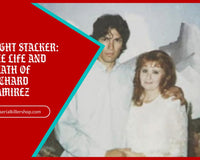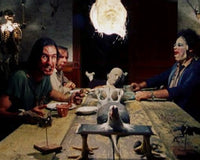The Acid Bath Murderer, John George Haigh, was a career fraudster and English serial killer. Haigh gained notoriety in mid-20th century England for his use of sulphuric acid to dispose of his victim's bodies. His story still resonates in public today through true accounts and adaptations of his crimes.
Here is a complete John George Haigh timeline: his life, crimes, and death.

July 24, 1909: John George Haigh is Born
Born in Stamford, Lincolnshire, John George Haigh was the son of engineer John Robert Haigh and his wife Emily, two conservative protestants. Haigh suffered from religious nightmares throughout his childhood, likely inspired by his parents and upbringing. He would claim these dreams affected him in later life as well.
Haigh's early life was marked by a love of music, and he was proficient at the piano. He would go on to follow in his father's footsteps as an engineer, but only briefly, before bouncing around several other jobs.
July 6, 1934: John Gets Married
John George Haigh married Beatrice "Betty" Hamer in the Summer of 1934, a coupling that would coincide with his earliest run-ins with the law. A few months after their marriage, Haigh was arrested for committing fraud.
Read Next: 15 Famous Serial Killers Last Meals
His wife Hamer did not wait for her husband's release, despite giving birth to his child while he was in prison. Betty Hamer left Haigh while in prison, giving their infant daughter up for adoption. This action would alienate Haigh from his religious family.
1936: Haigh's Crimes Continue
After his time in prison, Haigh moved to London, where he found work for William Donald McSwan as a chauffeur. Haigh, however, did not give up his propensity for fraud.
Haigh pretended to be a solicitor, selling stock shares that were as underpriced as they were fraudulent. His scheme only came undone when a potential victim noticed he had misspelled "Guildford," where his fictitious office was based.

Haigh would spend four years in prison for this crime, only getting released at the dawn of the Second World War, but it would not be his last time imprisoned for financial crimes. This was around the time that Haigh realized he would need to dispose of his victims before they could report his crimes.
September 6, 1944: John Takes his First Victim
Shortly after his last stint in prison, John Haigh ran into his former employer William McSwan at a pub in Kensington. McSwan introduced Haigh to his parents: Donald and Amy McSwan, for whom their son worked, collecting rent money on their behalf.
Haigh grew jealous of William McSwan and his lifestyle. Haigh smashed McSwan's skull with a lead pipe after luring him to a basement on Gloucester Street, then stuffed his body in a 40-gallon drum containing concentrated sulphuric acid. Haigh allowed McSwan's body to dissolve for two days before dumping the remains down a manhole.
July 2, 1945: The Death of the McSwan's
After disposing of McSwan's body, the Acid Bath Murderer developed a relationship with his former employer's parents.
As the war wound down, the McSwans became concerned about why their son had not returned. Haigh told the couple their son was in London for a surprise visit and that he would bring them to him.
Read Next: Rodney Alcala, The Dating Game Killer
Haigh surprised them instead with the same fate as their son, bludgeoning both Mr. and Mrs. McSwan in the head. Haigh disposed of the couple's bodies in drums of acid. He would go on to sell the McSwan's properties and move into a hotel in Kensington.
1947: Meeting the Hendersons
John Haigh fell into a large gambling debt following the deaths of the McSwan family. Haigh realized that murder was the only way to fund his fraudulent lifestyle.

After feigning interest in purchasing their property, Haigh developed a relationship with a local couple, Dr. Archibald Henderson and his wife, Rose. He was invited to the couple's flat to play piano for their housewarming party. There, Haigh stole a revolver from the collection of Dr. Henderson, storing it away for later use.
February 12, 1948: Murders of the Henderson's
In early 1948, Haigh put his plan into motion. He rented a workshop in Sussex, where he lured Archibald Henderson on the pretext of showing him an invention. Once there, Haigh cocked the revolver and shot Henderson in the back of the head with the stolen handgun, killing him.
Rose Henderson would suffer the same fate as her husband: Haigh shot Henderson and stuffed her body in a drum of sulphuric acid to dissolve. Haigh then brought Mrs. Henderson to the workshop, claiming her husband had fallen ill and needed urgent help. Like the McSwan's, Haigh sold the Hendersons possessions with forged signatures.
February 18, 1949: John's Last Murder
John Haigh continued targeting the vulnerable and the elderly. His next and final victim was Mrs. Olive Durand-Deacon, the widow of John Durand-Deacon. John was a wealthy salesman and fellow resident of the Onslow Court Hotel where Haigh lived.
Mrs. Durand-Deacon was brought to Haigh's Sussex workshop, believing he would help her develop an invention she had in mind. Haigh shot her from behind, stole all of her possessions, then disposed of her body in acid.
February 20, 1949: Olive Durand-Deacon is Reported Missing
Two days after the brutal murder of Durand-Deacon, she was reported missing by her friend Constance Lane. Police quickly discovered the long rap sheet of financial crimes of John George Haigh, which made him the primary suspect.
Haigh had made many fatal errors in the disposal of Olive Durand-Deacon. When police searched his workshop, they discovered a Persian lamb coat that belonged to Duran-Deacon. They also found several papers related to both the McSwan and the Hendersons.
Police discovered several pounds of dissolved human remains in the back of Haigh's workshop. Dr. Keith Simpson examined the dental records and confirmed that Mrs. Durand-Deacon's remains, and Haigh was arrested.
August 10, 1949: John Haigh is Executed
When Detective Inspector Albert Webb asked about the murders, Haigh replied, "Well, if I told you the truth, you would not believe me. It sounds too fantastic to believe." In this, Haigh was correct, as his trial became a media frenzy, despite Haigh's guilt being assured.
On August 10, John George Haigh was hanged, putting his terrifying spree to an end. The trial was held at Lewes Assizes, where Haigh argued insanity as the cause of his crimes. His defense was roundly rejected by officials and the jury. Even without the bodies of his victims, jurors took only minutes to find Haigh guilty of his crimes.
Sources:
- Honeycombe, Gordon (1984). The Murders of the Black Museum: 1870-1970. Wiltshire: Bloomsbury Books.
- Lane, Brian (1995). Chronicle of 20th Century Murder. Wiltshire: Select Editions.
- Root, Neil (2011). Frenzy!: Heath, Haigh, and Christie. London: Arrow Books












